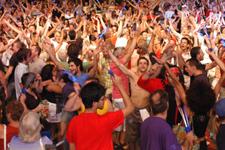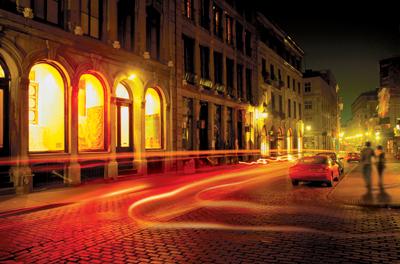
Credit: Aydin Matlabi/Divers/Cite
Rob Giacobbi moved his video store, Wilde’s, to Bank Street because he noticed that thousands of his clientele lived in the area. David Rimmer moved his bookstore, After Stonewall, which was originally in the Glebe, across the street because Giacobbi kept suggesting it.
It’s a common pattern that has emerged on the street known as the epicentre of Ottawa’s gay community.
Centretown Pub anchors the intersection of Bank and Somerset and, just down the street stands the queer-friendly Imperial Building at Bank and Cooper – home of Capital Xtra, Bruce House, the AIDS Committee of Ottawa and Planned Parenthood.
And just a block north is Venus Envy, which picked up and relocated from the Byward Market to its new home on Lisgar Street just a few years ago.
That sounds like at least the foundation of a gaybourhood, doesn’t it? But Ottawa’s gays now stand at a crossroads. Some activists – notably Glenn Crawford – seek an official village. It would take a concerted effort to approach municipal lawmakers and other local businesses in the area to secure that kind of broad support for a village. Crawford is already working towards it, but he’s not without his critics.
Other business owners would rather see the village grow organically, just as it has for the last couple of decades.
Rimmer sees why some want an official village, but he also has no real problem with how Bank Street has developed on its own.
“There might be some area of symbiotic assistance between the two ways of developing something. You can’t just make a village out of a ball of wax,” he says. “There have to be some elements there to begin with. At the same time, sometimes you can’t wait. You have to fertilize it in order to get it to grow.”
Venus Envy owner Shelley Taylor knows why some are wary of creating a deliberate village.
“A lot of people think of the idea of the gaybourhood as bringing a false sense of security in a homophobic world. It’s a very capitalist approach, because it’s business-based and trying to get the city involved,” she says. “It’s a real mainstreaming of queer culture.”
Nevertheless, Taylor isn’t opposed to the creation of an official village.
“If putting up a bunch of rainbow flags and delineating a neighbourhood as being gay-friendly or gay-positive would make the area safer for gays or would offer more acceptance in the general community, than I’m all for it,” she says.
But University of Ottawa social geography professor Brian Ray says that in order to create a real sense of community on Bank Street, it might take more than just labelling it a gaybourhood.
“I’m not sure if putting up rainbow flags is going to make it any more visible, because you need things on the street that actually encourage the community to be there,” he says.
Proponents of the Village, on the other hand, believe that a gaybourhood will attract business once it’s established. But business owners like Giacobbi and Rimmer are in no real rush to see any village declared official.
“I don’t think there is any urgency for it to happen,” says Giacobbi.
Given all these differences in opinion, where should Ottawa go from here? Should the Gay Village develop gradually, or should there be an effort to transform Bank St?
We looked to another Canadian city, Montreal, for the story on how they got past this hurdle.
Le Village
The debate between organic and deliberate growth is all but dead in Montreal. North America’s largest gay village sprawls across several blocks on Ste-Catherine Street and is fuelled by the Société de développement commercial du village (SDC), a coalition of local businesses that work together to promote their collective interests.
While the neighbourhood grew organically in its infancy, it has since been given official status. Its borders differ depending on the observer, but there is no doubt that Ste-Catherine — especially during the summer months when it is closed to traffic — is the home of Montreal’s gay community.
It was not always that way. Throughout the 1960s, gays and police frequently tousled over gay space, especially bars. At the time, the area around Ste Catherine and Stanley St (near the central YMCA) was where queer people congregated, according Tom Warner in Never Going Back, a history of Canadian, queer activism.
The fall of 1970 was a perfect storm. Gay liberation had found traction in the cultural revolution of Quebec. The community was emboldened. Meanwhile, then-Prime Minister Pierre Trudeau invoked the War Measures Act, suspending civil liberties across the province.
Police needed no further justification to begin yet another campaign of raids, this time without needing to adhere to procedural rules. Gays fought back. It lead to the founding of the militant Front de liberation homosexuel, the opening of a short-lived community centre (it too was raided) and a spike in Montreal queer consciousness.
However, with the 1976 Olympics looming in Montreal and a desire from official circles to clean up the city’s colourful downtown streets, the raids continued. During the mid-’70s, the community deliberately migrated away from Ste Catherine and Stanley, some two kilometres southwest along Catherine, to the area we now think of as Montreal’s gay village.
All of which may seem like ancient history now, but the lessons of intentional community remain valid today.
Several blocks north of the main drag, Joel Prevost and Rob Ross operate a bed and breakfast named La Loggia. Prevost studied community development at Ste-Anne University in the ’80s, and he then moved to Nanaimo, British Columbia, where he was for a while the executive director of a French community centre.
Prevost was raised in northern Quebec and has only lived in Montreal since 2003. When he was in Nanaimo, Prevost helped build a fledgling gay community, opened a public art gallery, and established a jazz festival. He says that giving a community — whether gay or otherwise — some kind of official status only helps it grow.
“The impact is that more people will go towards it — not just as tourists, but also to live there,” he says, adding that only when a variety of businesses make their home in an area will it become a cohesive community.
“You need a dentist, you need a doctor, you need a real estate agent. And without those things, it will not grow organically. Without defining a territory, there is less chance that it will ever happen.”
Prevost argues that without some kind of direction from the people within the community itself, a gaybourhood will rarely evolve in any meaningful way.
“When you let the market define itself, it doesn’t necessarily give you the direction that you would like,” he says. “As a matter of fact, it would not necessarily give you any direction, which is unhealthy for any community.”
Sophie Mhun, a yoga instructor who lives and works in Montreal’s village but was out of the province for 20 years, met and worked with Prévost on Vancouver Island. She says that a deliberate attempt to reach beyond the gay community strengthens the cohesion of a gay village.
“It’s not just about gay people, but it’s about accepting other people’s differences. It’s about human rights,” she says. “Having all kinds of people on board makes it more of a community thing, and not just about gay people.”
Indeed, businesses all along Ste-Catherine that don’t exclusively target the queer market still fly rainbow flags or colours in their windows — Starbucks and Tim Hortons included. And the Ste-Catherine entrance to the metro station in the middle of the village was redesigned in 1999 to incorporate six coloured masts that form a rainbow.
Mhun says that she and her colleagues in Nanaimo worked hard to make the gay community more visible, and it wouldn’t have happened without their efforts.
“The seed had been planted, so when I arrived…it was already going. But we worked hard at reaching out and making it happen,” she says.
Hans Janeak, the president of the Chambre de commerce gaie du Québec (CCGQ) — a province-wide coalition of gay businesses that was founded in 1997 — thinks it perfectly ordinary that, in most cities around the world, gay communities naturally coalesce around distinct areas.
“It should start as an organic entity. It should be natural for gay businesses to gather around the same strip. I think that has to come naturally,” he says. “In Montreal, we pushed it a bit further.”
Janeak says that in Montreal, organic growth took the Village as far as it could. When the SDC was founded, it began to receive funding based on business taxes levied by the city on businesses located on the gay stretch of Ste-Catherine.
He explains that businesses collectively fund the SDC so that they all benefit from the work that the organization does to promote the area.
“At a certain point, you need to have resources to market and build up your image and clean the streets and make them attractive,” he says.
“If you make a commercial zone known — not only to the GLBT community, but also the GLBT-friendly community — you can broadcast it as a place where you can shop and have fun.”
Without the marketing and beautification projects that result from these pooled resources, Janeak explains, business could slow down.
Prevost stresses the importance of a village in the simplest terms — without it, he says, people from outside of Ottawa won’t know where to start when it comes to getting involved in the gay community. He admits that if he were to move to Ottawa, he wouldn’t have any idea where to start.
And Prevost, for one, believes that a visible village doesn’t create a ghetto.
“In Montreal, gay men live all over the city, not just in the village. But at the same time, you have a high concentration in the village,” he says, adding that there are 22,000 residents in and around the village that represent a variety of lifestyles and identities.
Back home
Ottawa already contains several elements of a gaybourhood that might best be described as latent. Giacobbi says that when he moved to Bank and Maclaren, he had a consistent group of about 5,000 customers who lived in and around the neighbourhood. The Wilde’s owner says that number has remained stable in recent years. And it’s no secret that the number of queer and queer-friendly businesses in the area has steadily increased.
The most obvious difference between Bank St and Ste-Catherine is a collective will to develop the Village in a unified fashion. That approach spurred growth in Montreal for years. And it means that Montreal wins out as a weekend destination for many Ottawa gays.
What’s the essential difference between Ottawa and Montreal? Giacobbi was stuck for an explanation. Rimmer suggested that Montreal’s success has proven to be Ottawa’s downfall (“You still get buses flying off to Montreal on Friday evening with boatloads of boys”), but then he traces his indifference to its origins.
“What is the whole purpose of a Village?” he asks. “My understanding from the promoters is it’s basically a safe space. And to me, it already is a safe space here for queer people. It’s already happening here.”
On the other hand, Taylor says, it can’t really hurt to actively promote a Village.
“I think there is a legitimizing that happens when you put up flags and you name an area and you have the mayor come and say, you know, we’re proud today to blah, blah, blah,” she says. “I think legitimizing is important, and I think it goes a long way toward safety and acceptance. In that sense, it’s an excellent idea.”
Whether or not any mayor ever lends support to a gaybourhood depends on the will of the community to push for it.

 Why you can trust Xtra
Why you can trust Xtra


